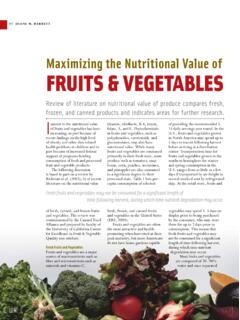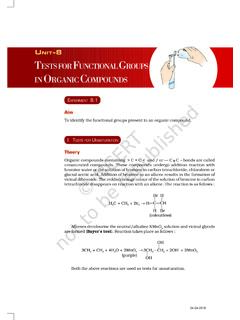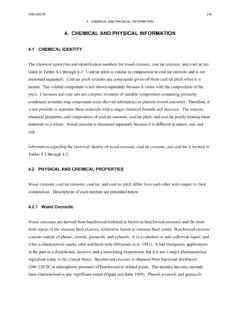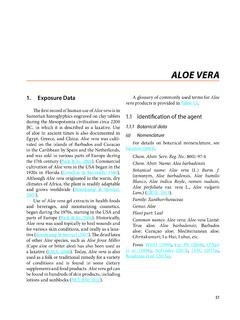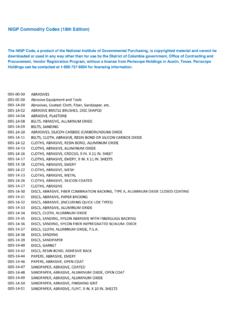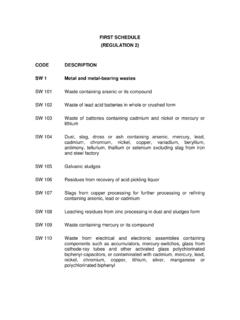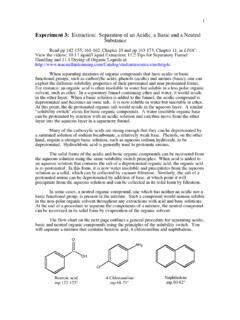Transcription of Preservative Treatments for Fresh-Cut Fruits and Vegetables
1 1 Preservative Treatments for Fresh-Cut Fruits and VegetablesElisabeth Garcia and Diane M. BarrettDept. of Food Science and TechnologyUniversity of California, DavisTable of Contents1. Introduction2. Fresh-Cut Products and Color Enzymatic Pre-Harvest Post Harvest and Processing Browning and Enzymes other than Control of Enzymatic Antibrowning Physical Treatments and Browning Reducing Oxygen Availability Modified Atmosphere Packaging Edible Reducing Applying Gamma Radiation Use of other Non-Thermal TechnologiesHigh Pressure TechnologyPulsed Electric Other Color White Yellowing or Degreening3. Prevention of Texture Loss in Fresh-Cut Fruit and Vegetable Tissue Calcium and/or Heat Use of modified atmosphere Water Loss PreventionLiterature CitedAppendix.
2 Evaluation of Enzymatic Browning21. IntroductionFrom the quality standpoint it is desirable to preserve the characteristics offresh-cut Fruits and Vegetables at their peak. What the consumer perceives asthe most appealing attributes of these products include their fresh -likeappearance, taste and flavor, in addition to convenience. Obviously, any foodproduct should be safe for consumption, and Fresh-Cut products are verysensitive to contamination. Among the limitations to shelf-life of fresh -cutproducts are: microbial spoilage, desiccation, discoloration or browning,bleaching, textural changes and development of off-flavor or , safety aspects are not discussed in this chapter, but werereviewed in Chapter III). The primary quality attributes of a food product includecolor, texture, flavor and nutritional value.
3 When assessing plant product quality,consumers take product appearance into consideration as a primary criterion,and color is probably the main factor considered (Kays, 1999).While conventional food processing methods extend the shelf-life of fruitsand Vegetables , the minimal processing to which Fresh-Cut Fruits and vegetablesare submitted renders products highly perishable, requiring chilled storage toensure a reasonable shelf-life. Preparation steps such as peeling or scrubbing,slicing, shredding, etc remove the natural protection (peel or skin) of Fruits andvegetables and cause bruises, rendering them susceptible to desiccation andwilting. This also exposes internal tissues to microbes and potentially deleteriousendogenous enzymes. Among the possible consequences of mechanicalinjuries to produce are increase in respiration rate and ethylene production,accelerated senescence and enzymatic browning (Rosen and Kader, 1989).
4 Inconventional types of fruit and vegetable processing, such as canning andfreezing, many of these problems are prevented or controlled by heat processingand consequent inactivation of enzymes, by the use of protective packagingmaterials, or through the application of various additives. In the production offresh-cut products, the use of heat is avoided in order to prevent cooking of theproduct, and consequently loss of fresh -like characteristics. Several chemicalpreservatives can be used, depending on what is to be prevented; often chemicalpreservatives are applied in the control of enzymatic browning, firmness anddecay (Brecht, 1992). Other important applications include the use of controlledmodified atmosphere packaging and edible films also have many survey on consumer perception of convenience products revealed thedesire that such products maintain fresh characteristics longer without the use ofpreservatives (Bruhn, 1994).
5 Unfortunately, depending on the type of qualitydefect to be prevented or controlled it is not always possible to avoid the use ofchemical Treatments . One important aspect to consider is the establishment ofconditions that allow for quality optimization at a reasonable shelf-life, ratherthan extending shelf-life at an acceptable quality (Shewfelt, 1994).In this chapter we review the most common Treatments , used to preservethe color and texture of Fresh-Cut products. Color preservation is, after safety, themost important attribute to be preserved, since frequently a product is selectedfor its appearance, particularly its color. Color has been considered to have a3key role in food choice, food preference and acceptability, and may eveninfluence taste thresholds, sweetness perception and pleasantness (Clydesdale,1993).
6 Secondly, texture loss and preservation in Fresh-Cut products will bediscussed, due to its important impact on product appearance and Fresh-Cut Products and Color PreservationFruits and Vegetables are attractive and eye-catching to a large degreebecause of the richness of pigments that they contain. Preservation ofchlorophyll in Vegetables , red to purple anthocyanins, yellow, orange and redcarotenoids in both Fruits and Vegetables is of vital importance to maintain changes (Figure 1) in Fresh-Cut Fruits and Vegetables may have differentorigins, for example decreased green pigmentation in Fresh-Cut lettuce may resultfrom senescence, heat exposure or acidification; discoloration or browning ofsliced mushrooms and sliced apples and pears is brought about through theaction of polyphenol oxidases; white blush development in carrots is initiallycaused by desiccation, and later lignification.
7 The main focus of this chapter ison prevention of enzyme-catalyzed browning, although some of the other colorchanges will be briefly Enzymatic BrowningEnzymatic browning is one of the most limiting factors on the shelf-life offresh-cut products. During the preparation stages, produce is submitted tooperations where cells are broken causing enzymes to be liberated from tissuesand put in contact with their substrates. Enzymatic browning is the discolorationwhich results from the action of a group of enzymes called polyphenol oxidases(PPO), which have been reported to occur in all plants, and exist in particularlyhigh amounts in mushroom, banana, apple, pear, potato, avocado and browning must be distinguished from non-enzymatic browning, whichresults upon heating or storage after processing of foods; types of non-enzymaticbrowning include the Maillard reaction, caramelization and ascorbic acidoxidation.
8 Enzymatic browning is a complex process, which can be subdivided intwo parts. The first reaction is mediated by PPO (Figure 2) resulting in theformation of o-quinones (slightly colored), which through non-enzymatic reactionslead to the formation of complex brown pigments. o-Quinones are highly reactiveand can rapidly undergo oxidation and polymerization. o-Quinones react withother quinone molecules, with other phenolic compounds, and with the aminogroups of proteins, peptides and amino acids, with aromatic amines, thiolcompounds, ascorbic acid, etc (Whitaker and Lee, 1995; Nicolas et al., 1993).Usually, brown pigments are formed, but in addition, reddish-brown, blue-grayand even black discolorations can be produced on some bruised plant variation in products of enzymatic oxidation is related to the phenoliccompounds involved in the reaction (Amiot et al.)
9 , 1997), and both color intensity4and hue of pigments formed vary widely (Nicolas et al., 1993). Consequences ofenzymatic browning are not restricted to discoloration, undesirable tastes canalso be produced and loss of nutrient quality may result (Vamos-Vigyazo, 1981).Biochemical details on PPO action were reviewed in Chapter 6. PPO has beenconsidered one of the most damaging enzymes to quality maintenance of freshproduce (Whitaker and Lee, 1995), and the prevention of enzymatic browninghas always been considered a challenge to food scientists (Ponting, 1960). Pre-Harvest FactorsSeveral parameters may contribute to the development of enzymaticbrowning. Agricultural practices, soil, fertilizers, climate and harvestingconditions all affect the final quality of Fresh-Cut products (Ahvenainen, 1996).
10 High nitrogen levels have been related to a greater tendency to brown inpotatoes (Mondy et al., 1979).The selection of raw material for processing needs to be carefullyevaluated. The susceptibility to brown may differ from cultivar to cultivar, asexemplified in Tables 1 and 2. Some tissues may have high PPO activity and/orhigh concentration or types of phenolic PPO substrates which, under appropriateconditions lead to a higher tendency to brown. In pears, it was found thatalthough the phenolic content tended to decrease with delayed harvest time, phenolic levels did not always correlate with the susceptibility to browning (Amiotet al., 1995). In general, high concentrations of phenolic compounds are found inyoung Fruits . While in bananas PPO activity is higher in the pulp than in the peel,in pear and apple, PPO activity is higher in the peel than in the flesh (Macheix etal.)
